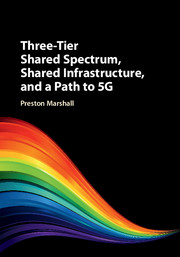Book contents
- Frontmatter
- Contents
- Acknowledgments
- Preface
- Part I Spectrum Sharing Background
- Part II Three-Tier Dynamic Spectrum Models
- Part III Components of a Three-Tier Architecture
- Part IV Protection Processes for Incumbents and Peers
- Part V Example Use of Three-Tier Spectrum: Use of the 3.5 GHz CBRS Band in the USA
- Part VI Future Bands, Network Services, Business Models, and Technology
- Part VII Appendices
- Appendix A Terms and Acronyms
- Appendix B Symbols
- Appendix C Opportunity Cost Model of Spectrum Utilization
- Index
- References
Appendix C - Opportunity Cost Model of Spectrum Utilization
from Part VII - Appendices
Published online by Cambridge University Press: 30 August 2017
- Frontmatter
- Contents
- Acknowledgments
- Preface
- Part I Spectrum Sharing Background
- Part II Three-Tier Dynamic Spectrum Models
- Part III Components of a Three-Tier Architecture
- Part IV Protection Processes for Incumbents and Peers
- Part V Example Use of Three-Tier Spectrum: Use of the 3.5 GHz CBRS Band in the USA
- Part VI Future Bands, Network Services, Business Models, and Technology
- Part VII Appendices
- Appendix A Terms and Acronyms
- Appendix B Symbols
- Appendix C Opportunity Cost Model of Spectrum Utilization
- Index
- References
Summary
The following material is abridged and slightly modified content from Chapter 4 of a previous book (Scaling, Density, and Decision-Making in Cognitive Wireless Networks) by the author [1]. It was published in 2012, also by Cambridge University Press. One of the book's premises was that spectrum utilization should be considered to be the quantification of the lost opportunity cost resulting from one user's application on all other users of the same spectrum, and it treated receiver protection and emitter impacts symmetrically. This model was adopted in the President's Council of Advisors on Science and Technology (PCAST) report [2], Appendix B (Proposed New Metric for Spectrum Use) to explain the focus on reducing default receiver protection, or at least reflecting it in the cost charged to spectrum users for the protection.
Key Objectives for Introducing Cognitive Processes to Wireless Systems
When communications engineering and operations was dominated by individual links, the evaluation and optimization of these links was relatively scalar; maximize the link performance, or minimize the resources required, to achieve a given link performance. As wireless has moved from wireless access to wireless networking, the evaluation process is much less scalar, and the objectives of optimization are often competing. We will examine four metrics of the aggregate effect of network decision-making. We will see that these metrics are not independent or orthogonal, but approaching them with this assumption is convenient to the early analysis steps, before they are “entangled.”
Capability (Cnet): We will consider capability to be from the demand to the source of information for the mean request. This metric is therefore not just a metric of the packet network, but also includes the consequences of content location.
Reliability (P(C)): The network reliability is considered in the context of the other three metrics. It is the probability of achieving a given capacity in a network of given total membership (scalability) and mean density.We express this as a function of the capacity.
Scalability (n): The total number of nodes forming a single address space and for which all other nodes must be sufficiently aware of their location, reachability, or address to communicate.
- Type
- Chapter
- Information
- Publisher: Cambridge University PressPrint publication year: 2017



